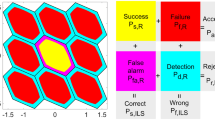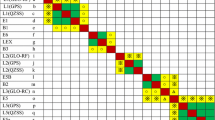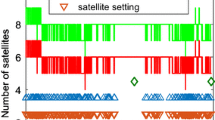Abstract
The global navigation satellite system (GNSS) can provide single-epoch differential positioning services for geological disasters with a sudden and instantaneous nature. It needs fast and precise monitoring, which lies in the rapidly and correctly fixing ambiguities of GNSS. Compared to a single-frequency single system (SF-SS), multiple GNSSs (multi-GNSS) can achieve a high success rate (SR), but the positioning becomes time- and power-consuming due to its large number of visible satellites. Satellite selection and partial ambiguity resolution (PAR) can improve the positioning efficiency of multi-GNSS, but they cannot achieve precise and high-SR rapid positioning. How to effectively utilize multi-GNSS observations to achieve fast, precise, and high-SR single-epoch positioning becomes crucial. Hence, the following theory and method are developed. The roles of code and carrier observations in precise and high-SR positioning are theoretically analyzed. Then, the relationships between position dilution of precision and ambiguity dilution of precision (ADOP) are established by adopting the Schur-Horn Theorem, Majorization Theorem, and Weyl Theorem. Based on the above analyses, a PAR method of ADOP-based BeiDou navigation satellite system (BDS)/Galileo system (Galileo) augmenting global positioning system (GPS) (A-GPS/BDS/Galileo) is proposed. The single-epoch relative positioning results of SR, positioning accuracy, time consumption, and the R-ratio test-based fixed reliability demonstrate that A-GPS/BDS/Galileo outperforms the traditional SF-SS and single/dual-frequency multi-GNSS methods: it can achieve fast and precise positioning with an empirical SR of 100.0%; its R-ratio test-based accept, successfully fixed, failure, detection, and false alarm rates can be up to 98.5%, 100.0%, 0.0%, 0.01%, and 1.5%, respectively.










Similar content being viewed by others
Data Availability
GNSS data used in this study from Hong Kong base station, China, can be accessed at: https://www.geodetic.gov.hk/en/rinex/downv.aspx.
References
Bai Z, Zhang Q, Huang G, **g C, Wang J (2019) Real-time BeiDou landslide monitoring technology of “light terminal plus industry cloud.” Acta Geodaetica Et Cartographica Sinica 48(11):1424–1429
Bevilacqua A, Neri A, De Martino P, Isaia R, Novellino A, Tramparulo F, Vitale S (2020) Radial interpolation of GPS and leveling data of ground deformation in a resurgent caldera: application to Campi Flegrei (Italy). J Geodesy 94(2):24
Boyd S, Vandenberghe L (2004) Convex optimization. Cambridge University Press, Cambridge
Brack A (2017) Reliable GPS+BDS RTK positioning with partial ambiguity resolution. GPS Solut 21(3):1083–1092
Horn R, Johnson C (1999) Matrix analysis. Cambridge University Press, Cambridge
Horn R, Rhee N, So W (1998) Eigenvalue inequalities and equalities. Linear Algebra Appl 270:29–44
Huang P, Rizos C, Roberts C (2018) Satellite selection with an end-to-end deep learning network. GPS Solut 22(4):108
Lancaster P, Tismenetsky M (1985) The theory of matrices with applications. Academic Press, San Diego
Li B, Shen Y (2009) Fast GPS ambiguity resolution constraint to available conditions. Geomat Inf Sci Wuhan Univ 34(1):117–121
Li B, Feng Y, Shen Y (2010) Three carrier ambiguity resolution: distance-independent performance demonstrated using semi-generated triple frequency GPS signals. GPS Solut 14(2):177–184
Li J, Yang Y, Xu J, He H, Guo H (2015) GNSS multi-carrier fast partial ambiguity resolution strategy tested with real BDS/GPS dual- and triple-frequency observations. GPS Solut 19(1):5–13
Liu X, Zhang S, Zhang Q, Ding N, Yang W (2019) A fast satellite selection algorithm with floating high cut-off elevation angle based on ADOP for instantaneous multi-GNSS single-frequency relative positioning. Adv Space Res 63(3):1234–1252
Liu X, Zhang S, Zhang Q, Zheng N, Zhang W, Ding N (2021) Theoretical analysis of the multi-GNSS contribution to partial ambiguity estimation and R-ratio test-based ambiguity validation. GPS Solut 25(2):52
Marshall A, Olkin I (1979) Inequalities: theory of majorization and its applications. Academic Press, New York
Nie Z, Gao Y, Wang Z, Ji S (2017) A new method for satellite selection with controllable weighted PDOP threshold. Surv Rev 49(355):285–293
Odijk D, Teunissen P (2008) ADOP in closed form for a hierarchy of multi-frequency single-baseline GNSS models. J Geodesy 82(8):473–492
Odolinski R, Teunissen P (2016) Single-frequency, dual-GNSS versus dual-frequency, single-GNSS: a low-cost and high-grade receivers GPS-BDS RTK analysis. J Geodesy 90(11):1255–1278
Odolinski R, Teunissen P, Odijk D (2015) Combined BDS, Galileo, QZSS and GPS single-frequency RTK. GPS Solut 19(1):151–163
Odolinski R, Teunissen P, Odijk D (2013) An analysis of combined COMPASS/BeiDou-2 and GPS single- and multiple-frequency RTK positioning. In: Proceedings of ION PNT 2013, Institute of Navigation, Honolulu, Hawaii, USA, April 23–25, pp 69–90
Phillips A (1984) Geometrical determination of PDOP. Navigation 31(4):329–337
Schur I (1923) Über eine Klasse von Mittelbildungen mit Anwendungen auf die Determinantentheorie. Sitzungsber Berl Math Ges 22:9–20
Teunissen P (1995) The least-squares ambiguity decorrelation adjustment: a method for fast GPS integer ambiguity estimation. J Geodesy 70:65–82
Teunissen P (1997) A canonical theory for short GPS baselines. Part IV: precision versus reliability. J Geodesy 71:513–525
Teunissen P, Verhagen S (2009) The GNSS ambiguity ratio-test revisited: a better way of using it. Survey Rev 41(312):138–151
Teunissen P, Odolinski R, Odijk D (2014) Instantaneous BeiDou+GPS RTK positioning with high cut-off elevation angles. J Geodesy 88(4):335–350
Teunissen P, Joosten P, Tiberius C (1999) Geometry-free ambiguity success rates in case of partial fixing. Proc. ION NTM 1999, Institute of Navigation, San Diego, CA, USA, January 25–27, pp 201–207
Verhagen S, Teunissen P (2006) New global navigation satellite system ambiguity resolution method compared to existing approaches. J Guid Control Dyn 29(4):981–991
Wang J, Feng Y (2013) Reliability of partial ambiguity fixing with multiple GNSS constellations. J Geodesy 87(1):1–14
Wang K, Teunissen P, El-Mowafy A (2020) The ADOP and PDOP: two complementary diagnostics for GNSS positioning. J Surv Eng 146(2):04020008
Yang Y, Li J, Xu J, Tang J, Guo H, He H (2011) Contribution of the compass satellite navigation system to global PNT users. Chinese Sci Bull 56(26):2813–2819
Zaminpardaz S, Teunissen P, Nadarajah N (2017) GLONASS CDMA L3 ambiguity resolution and positioning. GPS Solut 21(2):535–549
Acknowledgements
The authors are very grateful for the comments and remarks of the reviewers who helped to improve the manuscript. This work was supported by the Natural Science Foundation of Jiangsu Province (No. BK20221146 and No. BK20191342), the Project funded by the China Postdoctoral Science Foundation (No. 2021M703496), and the Open Research Fund of Jiangsu Key Laboratory of Resources and Environmental Information Engineering, CUMT (No. JS202109).
Author information
Authors and Affiliations
Corresponding authors
Additional information
Publisher's Note
Springer Nature remains neutral with regard to jurisdictional claims in published maps and institutional affiliations.
Appendices
Appendix A: Schur-Horn Theorem (Horn et al. 1998; Schur 1923)
If \(\varvec{C} = \left( {c_{ij} } \right)_{n \times n} \in \varvec{M}_{n}\) is a Hermite matrix, \(c_{11}^{ \uparrow } + \cdots + c_{mm}^{ \uparrow } \ge \gamma_{1}^{ \uparrow } + \cdots + \gamma_{m}^{ \uparrow }\) holds for every \(m = 1, \cdots ,n\) with equality for m = n, where \({\upgamma }_{{\text{i}}}\) (\(i = 1, \cdots ,n\)) is the eigenvalue of C, ‘\(\uparrow\)’ denotes the increasingly ordered symbol, and \(\varvec{M}_{n}\) denotes the space of \(n \times n\) complex matrices.
Appendix B: Majorization Theorem (Marshall and Olkin 1979)
Let \(\varvec{x} = \left[ {\begin{array}{*{20}c} {x_{1}^{ \uparrow } } & \cdots & {x_{n}^{ \uparrow } } \\ \end{array} } \right]\) and \(\varvec{y} = \left[ {\begin{array}{*{20}c} {y_{1}^{ \uparrow } } & \cdots & {y_{n}^{ \uparrow } } \\ \end{array} } \right]\) \(\in {\varvec{R}}^{{\text{n}}}\), where \({\varvec{R}}^{{\text{n}}}\) denotes the space of n-order real vectors. If \(\mathop \sum \nolimits_{i = 1}^{m} x_{i} \ge \mathop \sum \nolimits_{i = 1}^{m} y_{i} (1 \le m \le n - 1)\) and \(\mathop \sum \nolimits_{i = 1}^{n} x_{i} = \mathop \sum \nolimits_{i = 1}^{n} y_{i}\) hold, it is said that x is majorized by y, which is denoted by \({\varvec{x}} \prec {\varvec{y}}\). Specially, \(\underbrace {{\left[ {\begin{array}{*{20}c} {\overline{x}} & \cdots & {\overline{x}} \\ \end{array} } \right]}}_{n} \prec {\varvec{x}}\) with \(\overline{x} = \left( {\mathop \sum \nolimits_{i = 1}^{n} x_{i} } \right)/n\) always holds, which can be easily proved by mathematical induction.
Appendix C: Weyl Theorem (Lancaster and Tismenetsky 1985)
Let U and V \(\in {\varvec{M}}_{{n}}\) are Hermite matrices. Then \(\eta_{i} ({\varvec{U}} + {\varvec{V}}) \ge \left\{ {\begin{array}{*{20}c} {\begin{array}{*{20}c} {\eta_{i} ({\varvec{U}}) + \eta_{1} ({\varvec{V}})} \\ {\eta_{i - 1} ({\varvec{U}}) + \eta_{2} ({\varvec{V}})} \\ \end{array} } \\ {\begin{array}{*{20}c} \cdots \\ {\eta_{1} ({\varvec{U}}) + \eta_{i} ({\varvec{V}})} \\ \end{array} } \\ \end{array} } \right.\) and \(\eta_{i} ({\varvec{U}} + {\varvec{V}}) \le \left\{ {\begin{array}{*{20}c} {\begin{array}{*{20}c} {\eta_{i} ({\varvec{U}}) + \eta_{n} ({\varvec{V}})} \\ {\eta_{i + 1} ({\varvec{U}}) + \eta_{n - 1} ({\varvec{V}})} \\ \end{array} } \\ {\begin{array}{*{20}c} \cdots \\ {\eta_{n} ({\varvec{U}}) + \eta_{i} ({\varvec{V}})} \\ \end{array} } \\ \end{array} } \right.\) hold, where \({\varvec{\eta}} (*)= \left[ {\begin{array}{*{20}c} {{{\eta}_{1}^{\uparrow}}(*)} & {\cdots} & {{{\eta}_{n}^{\uparrow}} (*)} \\ \end{array} } \right]\) is the eigenvalue vector of ‘*’ with ‘*’ be U, V, or U + V.
Rights and permissions
Springer Nature or its licensor holds exclusive rights to this article under a publishing agreement with the author(s) or other rightsholder(s); author self-archiving of the accepted manuscript version of this article is solely governed by the terms of such publishing agreement and applicable law.
About this article
Cite this article
Liu, X., Wang, Q., Zhang, S. et al. A new efficient fusion positioning method for single-epoch multi-GNSS based on the theoretical analysis of the relationship between ADOP and PDOP. GPS Solut 26, 139 (2022). https://doi.org/10.1007/s10291-022-01319-y
Received:
Accepted:
Published:
DOI: https://doi.org/10.1007/s10291-022-01319-y




